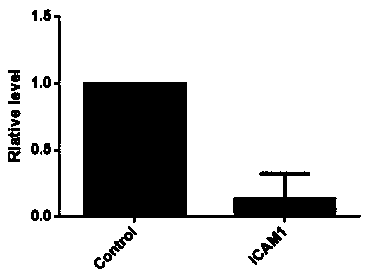Molecular marker for diagnosis and prognosis judgment of canine breast tumor
A technology of molecular markers and mammary gland tumors, which is applied in the field of molecular markers for the diagnosis and prognosis of canine mammary gland tumors, can solve the problems of misdiagnosis or missed diagnosis, insufficient specificity and sensitivity, and difficult popularization of joint diagnosis, etc., and achieve high sensitivity and specificity, the effect of improving the survival rate
- Summary
- Abstract
- Description
- Claims
- Application Information
AI Technical Summary
Problems solved by technology
Method used
Image
Examples
Embodiment 1
[0055] Example 1 RT-qPCR method to detect the mRNA expression level of ICAM1 in canine mammary gland tumor tissue
[0056] 1. Experimental method
[0057] 1. Sample storage and processing
[0058] The surgically resected fresh tumor tissue was washed with PBS to clean the blood stains and hair on the surface of the tissue, and then the cancer tissue and paracancerous tissue (less than or equal to 2 cm away from the cancer lesion) were separated and decomposed into 1 cm × 1 cm tissue blocks and placed in sterilized EP. Immediately after the tube was frozen with liquid nitrogen, and then stored at -80°C for later use; a part of the tissue from each sample was fixed with 4% paraformaldehyde for subsequent paraffin-embedded sections and sent to Nabok clinical animal clinical testing in Germany Laboratory identification.
[0059] 2. Preparation of pathological sections and HE staining
[0060] The canine breast tumor tissue samples collected clinically were paraffin-embedded, se...
Embodiment 2
[0100] Example 2 RT-qPCR method to detect the mRNA expression level of ICAM1 in CHMm and CHMp cells
[0101] 1. Culture of canine breast tumor cells CHMm and CHMp
[0102] 1. Recovery of canine breast tumor cells CHMm and CHMp
[0103] Take the CHMp and CHMm cells out of the liquid nitrogen and quickly put them into a 37°C water bath and shake them constantly to dissolve them quickly; transfer them to 15mL centrifuge tubes after the cells in the cryopreservation tubes are completely thawed, add 10mL DMEM to each tube and Repeatedly blow and mix; then centrifuge at 2,000rpm for 5min; discard the supernatant, resuspend the cells with 1mL complete cell culture medium (90% DMEM, 10% serum, 1% double antibody) and transfer them to a 25cm2 adherent cell culture flask After adding 4mL of complete medium to each bottle, culture them in an incubator at 37°C containing 5% CO2. After 24 hours, observe under the microscope, if most of the cells adhered to the wall normally, and only a s...
Embodiment 3
[0122] Example 3 A kit for diagnosis and prognosis of canine mammary gland tumors
[0123] 1. A kit for the diagnosis and prognosis of canine mammary gland tumors
[0124] A kit for diagnosing and judging prognosis of canine mammary gland tumors, containing RT-qPCR detection primers for detecting ICAM1 gene expression, the nucleotide sequence of which is shown in SEQ ID NO: 2-3; the internal reference gene is RT-qPCR of β-actin qPCR detection primer, the nucleotide sequence of the RT-qPCR detection primer is shown in SEQ ID NO: 4-5; it also contains ddH 2 O. SYBR GreenⅠMaster.
[0125] 2. How to use the kit
[0126] The method of using the kit is as follows: extract total RNA from the sample, synthesize cDNA, and perform RT-qPCR.
[0127] S1. extract the total RNA of the sample;
[0128] S2. Synthesizing cDNA;
[0129] S3. Perform RT-qPCR.
[0130] Among them, the total volume of the RT-qPCR system is 20 μL, specifically: ddH 2 O 7.2 μL; SYBR GreenⅠMaster 10 μL; forward...
PUM
| Property | Measurement | Unit |
|---|---|---|
| Thickness | aaaaa | aaaaa |
Abstract
Description
Claims
Application Information
 Login to View More
Login to View More - R&D
- Intellectual Property
- Life Sciences
- Materials
- Tech Scout
- Unparalleled Data Quality
- Higher Quality Content
- 60% Fewer Hallucinations
Browse by: Latest US Patents, China's latest patents, Technical Efficacy Thesaurus, Application Domain, Technology Topic, Popular Technical Reports.
© 2025 PatSnap. All rights reserved.Legal|Privacy policy|Modern Slavery Act Transparency Statement|Sitemap|About US| Contact US: help@patsnap.com



